
About Ancient Illyria
Mr. and mrs. average seldom knows anything about "Illyria". Some thinks it's a common -somewhat pretty and therefore female- forename, while others thinks it's a region they have a hard time to locate. As history buffs and versed into ancient warfare, we know better. In the back of our memory we know this small region of the Balkans was never really united, was home to brigands as described by the Greeks and pirates, for the Romans. We know also there was some Roman expedition against Illyria, which subsequentely became the first Roman provinces outside of Italy. Indeed from that date -222 BC- Illyrian history as an independent kingdom or ensemble of independent states, ends. So, did the Illyrians were a threat to anyone ? Did they bring anything to the world's civilization ? That' s two and the many other questions we will try to tackle in this monthly chapter.
Illyrian map and Tribes
The Illyrians are peculiar in Europe as their origins still instilled debate, controversy and even passionated stances by hitorians, especially local. Nationalistic History aside, the illyrians are know recoignised, with the Thracians, their "Germans" as they were also close each other than the Celts and Germans to the eyes of the Greco-Latins, as the most ancient inhabitants of Europe, with many traces of settlements dating back from the bronze age. Their language was common from the Adriatic Sea to southeastern Italy, both sides of this particular sea, which at one point was almost an "Illyrian Lake". Known since a long time by southern greek city-States, the illyrians were assimilated to unwashed, uncivilized barbarians. The first attested Illyrian civilization was attributed to the Enchelii tribe in the 8th Century.
This was a large geographic area, the size of Italy, encompassing modern Albania, Croatia, Bosnia-Herzegovina, Slovenia, Montenegro, and part of Serbia. When picturing the safe havens of Illyrian pirates we can now gaze at touristic brochures for Croatia, with pristine seas and high rocky cliffs. If the region is politically diverse and divided today, it was so in the antiquity with a dozen of main tribes and many other client tribes. One of the tribes, the Dardanii, was in effect half-Thracian and half-Illyrian. Their pannonian northern neighbours were also difficult to identify. So here are these tribes/nations/kingdoms and their story. It is quite possible also Bronze Age Greeks knew a northern tribe known as the "Illyri", which passed on by assimilation to encompass the whole region.

In Italy, Ilyrian culture also applied to Iapyges, Dauni and Messapi. In mythology, Illyrius was the son of Cadmus and Harmonia, which settled and ruled the country that bears his name. His numerous sons and daughters names were passed onto their respective tribes, like Autarieus, Dardanus, or Taulas. it is generally admitted now, that ancestors of the illyrians were nomadic Indo-Europeans from the steppe which settled in this region in the bronze age bringing with them the Kurgan culture. The Romans willfully respected them as "tall, well built and formidable warriors", some wearing torques like the Celts, and also despised like them "unpredictable, turbulent, and warlike". North of Epirus or Macedon, these semi-barbarian border kingdoms, were no-man's land populated by savage pirates.
About ancient Dardania
Due to their intermediate location, the Dardanians borrowed tactics and wepaponry from the illyrians and Thracians alike. Added to that, they possessed some plains ideal to raise horses, and therefore used cavalry but also hoplites as seen above. A potent mix that explains their early successes.

Dardano-Illyrian helmet, wore by a nobleman, perhaps even a king. Illyrian helmets were modelled after eal Greek helmets, long before they transformed into more elaborate models like the Achaian one, through the well-known Corithian model. The other popular helmet was the "pot" or Negau type. They apparebtly often had attachment to glue some horse hair, and therefore were crested. These models were also used by many Italic warriors, and Alpine Celts as well. The third model was deduced by remnants of wicker and studs, and was named the "wicker and stud" helmet. Called the Shmarjet helmet, it was made by the Japodes in the Lika valley. The current model was made of wicker on which chain-mail while side metal plates were mounted. It was a medium-class warrior improvized helmet. In addition, leather helmets would probably have been very common, but being made in such perishable material, none survived. However the immense majority of peasant levies were bare-headed.
About Dardanian warfare
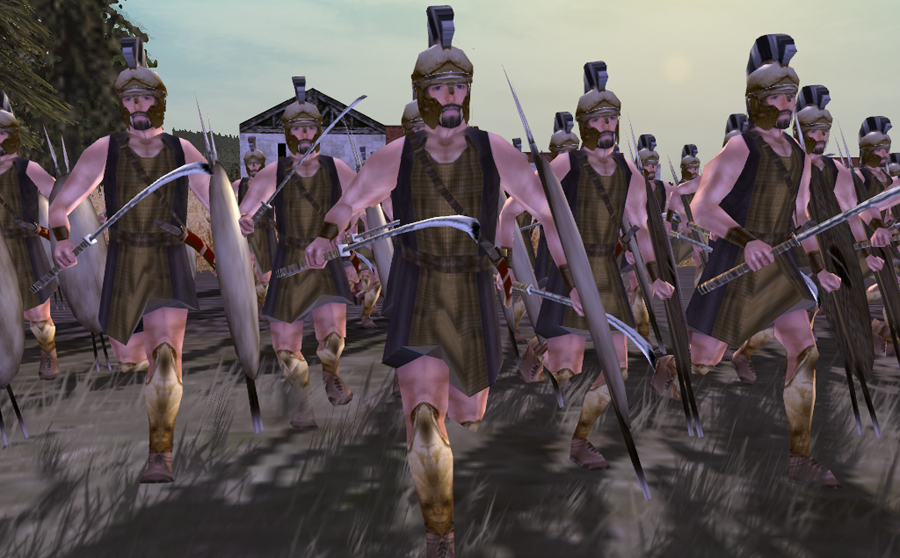
Rendition in CATW of "Dardanoi Romphaiorioi", Dardanian warriors with a Romphaia Being mid-way between the "proper Illyrians" from coastal areas, and the Thracians in the East, Macedon in the south, Autariatae and Triballi in the north and beyond threatening Celts in the North; the Dardanians also lived in fertile plain estendin norths-south and sandwiched between mountains, that were right for horse-breeding. They also took influences from each of these civilizations. Representation of Dardanian warriors is sketchy at best. One Illyrian weapon that has been noted of wide use, spread all around the Balkans as it was also used by the Detic (and later Dacian) peasantry and Thracians, was the Sica. This was an agricultural tool, made for harvesting in summer; Since levied peasantry made the bulk of armies in these areas, all available tool was used in battle, such as the Sica, but hammers and maces, axes also. The Sica was a close-quarter combat "sabre" with an inverted blade, which made its use a gruesome process. It was used to strike heavy blows, hoping to pierce whatever armour the adversary had, and then cut through flesh and bone. It is dubious it was enough to detach an arm, but it can make quite appaling injuries anyway. It was however unwieldy and less agile than a straight sword, and cannot be used for thrusting.

Dardanians as depicted in Rome 2 TW
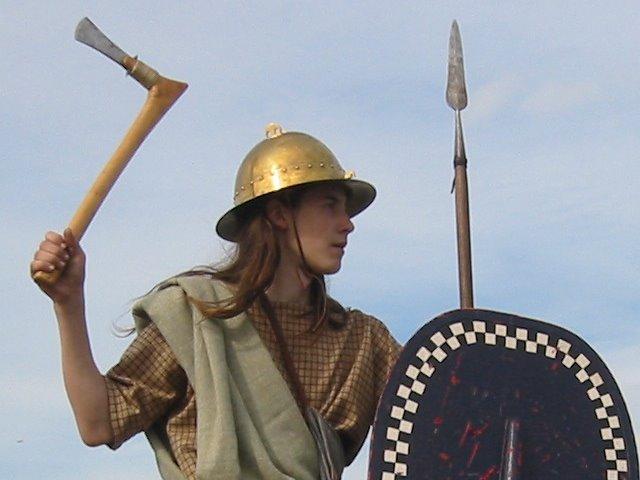
A German reenacter of an Illyrian warrior, showing the old-style bronze age axe, wooden shield and Negau helmet
It is possible, but conjectural, that the Dardanian warrors (of the warrior class that surrounded nobles) carried a Romphaia in combat. This amazing two-handed weapon had a very long grip which allowed the bearer to wield it with great force. It was said a Romphaia had no problem cutting a man in two, armour included. For the rest, Greek swords, either purchased or captured, were always a great prize, either a Xiphos or kopis, whereas the Machaira was probably most common about cavalry. We do not have many clues abiut how cavalry was used either. We can only guess as there was no tradition of horse archery or cataphracts, that outsude the heavy cavalry guard that protected the king, made by noblemen and their own bodyguards, formed the core of that cavalry, the immense majority being made by light horsemen fighting with javelins and their own close combat weapon, sica, axe, or sword, and a light spear.
About Illyrian warfare
The first proto-state was funded by the Enchelii tribe even before the iron age, but was soon shadowed by the Taulanti in the 7th century BC. Pleurias (337 BC) funded the Autariatae Kingdom and soon the Ardiaei rose to fame in 230 BC. The kingdom however ended at 167 BC. Bardyllis of the Dardani and Agron of the Ardiaei both created powerful states. Agron extended his rule to nearby tribes and almost succeeded to unify Illyria. However Bardilys of the Dardanians succeeded in this attempt. As for the Dalmatians, (see below) they always had separate domains from the rest of the Illyrians and a slightly different culture, mid-way between Thrace and the Celts, so they considered themselves apart from the coastal tribes, more under Greek influence.
Even more succesful, in the 4th century BC Bardyllis of the Dardanians became the first recorded "king of the Illyrians". He gradually united all nearby tribes and created a new dynasty which made power relations changes with Macedonia. He also pioneered new war tactics in 393 BC when winning a decisive battle against Macedonian king Amyntas III (Father of Philip II). He expelled him and ruled Macedonia through a puppet king. However in 392 BC the future Amyntas III allied with the Thessalians and managed to taking back Macedonia under his rule. But Bardyllis quickly seeing this overtake as an outrage multiplied large scale raids and eventually forced the Macedonians to pay an annual tribute, in 372 BC. This context shaped the young Philip II body (he lost an eye) and mind, as father of Alexander.
With a situation cleared and financed obtained, Bardillys turned naturally his attention to the south. Here lied a large choice of divided but prosperous city states, like an invitation for plundering. In 385 BC Bardyllis raided Epirus, ruled by the Molossians. He cound count an adversaries of the small Kingdom, such as by Dionysius of Syracuse. Alcetas was his protégé, a refugee at his court for a rival dynasty. So he wanted as price him accessing to the throne and control of the Ionian Sea. Sparta under Agesilaus intervened at that point to balance the situation. They succeeded in repelling the Illyrians. The latter were aided by 2000 Greek hoplites plus five hundred foot nobles and veterans equipped with Greek armour. Agesilaus then ravaged the region and slaughtered 15,000 Molossians. In 360 BC, the Illyrians were back in force to crush the Epirot army and chased out the Molossian king Arymbas to Aetolia. The entire kingdom was looted and entire villages burnt. However the Molossians had managed to saved most of their army intact, waiting for the Illyrian army to split up to prey on booty, and afterwards starting to walk back home. With their encumbered columns, they were ambushed and crushed by Arymbas.
The same year, but later, the southern Paeonians launched quick raids (mostly cavalry) against Macedonia, to draw Macedonian forces out of the future path of an Illyrian invasion in 359 BC by Bardyllis; He won a decisive battle against Perdiccas III, killing the king and 4,000 soldiers. Cities of upper Macedonia were occupied and later attempts to recover the throne failed. King Philip took control of throne in 358 BC, and tried to appease Bardilys, reaffirming the treaty with the Illyrians and marrying the Illyrian princess Audata. This gave the young king ample time to prepare his forces. He managed to defeat an army still led by an ageing Bardilys (aged 90) in the Erigon Valley battle. 7,000 Illyrians were killed and the rest retreated, while Bardyllis was also killed himself. Philip II refused a later peace treaty and started a serie of milirary campaigns against the Illyrians, in order to train his army and new tactics in battle. The southern Illyrian states were eventually subjected by Alexander the Great in 335 BC. That was the end of the Dardanian domination in the area and the end of the dream of an unified Illyria, which resurfaced under Teuta of the Ardiaei a century after.
It should be noted also that Illyrians sometimes actes as mercenaries, but they were often seen as unreliable. Perdiccas II of Macedon own mercenaries swapped sides to ally with Arrhabaeus of Lyncus. Lysimachus's own Illyrians defected to Antigonus and in another occasion when he was convinced of their near betrayal, executed 5,000 Autariatae. In general they were skilled warriors, but lightly equipped and of moderate to poor value and ill-disciplined. The Thracians, despite their ferocity were deemed more reliable and better equipped/skilled despite using generally similar tactics and warfare.
About ancient Dalmatia

This name of the region was of the Delmatae Illyrian tribe, later Romanized. This region locked between the coast and mountains stretched between Istria in the north to modern-day Albania in the south and represented the core of the Illyrian civilization. Indeed a powerful kingdom was established there, from which emerged an attempt to unite the tribes. They were related to the eastern Illyrians and northern Pannonii. Celtic influences were also noted, especially in the north. One Dalmatian tribe known the Baridustae later was migrated in Roman Dacia. A solid weapons industry existed and while the elite had large stone houses, numerous Delmatic herdmen settled in natural caves. Outside the tunic, their naturel clothing item was the fur cap. This was still a nomadic society with a traditional patriarchal structure. Shepherds, warriors and chieftains made the bulk of this society, and cattle breeding bing arely sufficient for the sustainance of the people, and regularly plundering of nearby tribes and richer coastal towns. Barely matter for a world empire.
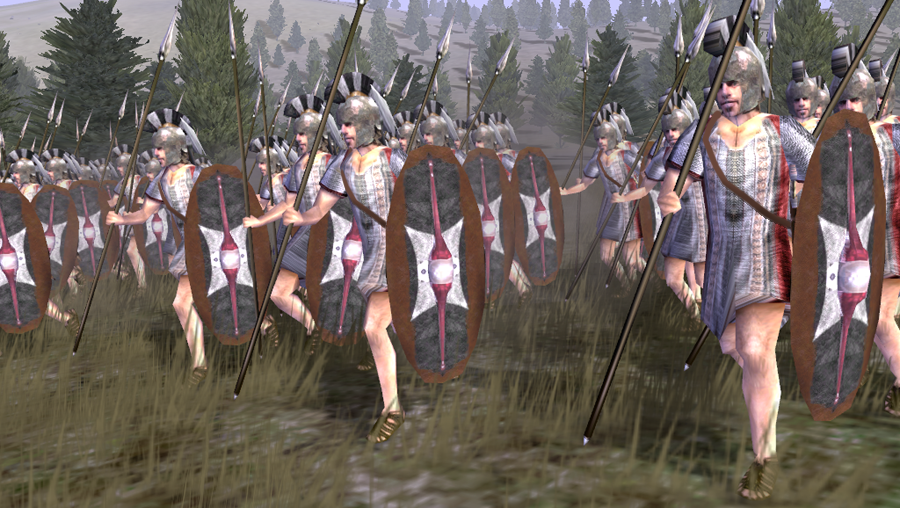
Ardiaei spearmen
Delmatian warfare was of course largely dictated by local conditions. Nomadic Delmatae raided all of their neighbours, the Liburni, Daorsi, Ardiei, but also the southern Greek Issaean federation of City-states. The Aristocracy probably used old war gear passed from generations, bronze thorax, bronze aspis, greaves and old-style 500 BC helmet. Local chieftain were perhaps the only ones mounted with a few followers, client warriors, the immense majority of the infantry, besides foot infantry was peasant levy. Shepherds, mountaineers, made excellent slingers and skirmishers. The rocky surroundings counted little woods, so archers must have been rare in between. Warriors used a variable panoply, rarely with armour better than wicker, if at all. Pot helmets and disc and stud ones, and the usual oblong or rectangular wooden shield. The terrain, by any standard, was fit for guerilla. In addition, the country was dotted by 400 stone fortresses and 50 major citadels, high up on the most forbidding eagle's nests. This made for excellent hideout after a raid. The region was eventually pacified after three wars with Roman legions, from 156 to 76 BC.
About Illyrian Pirates
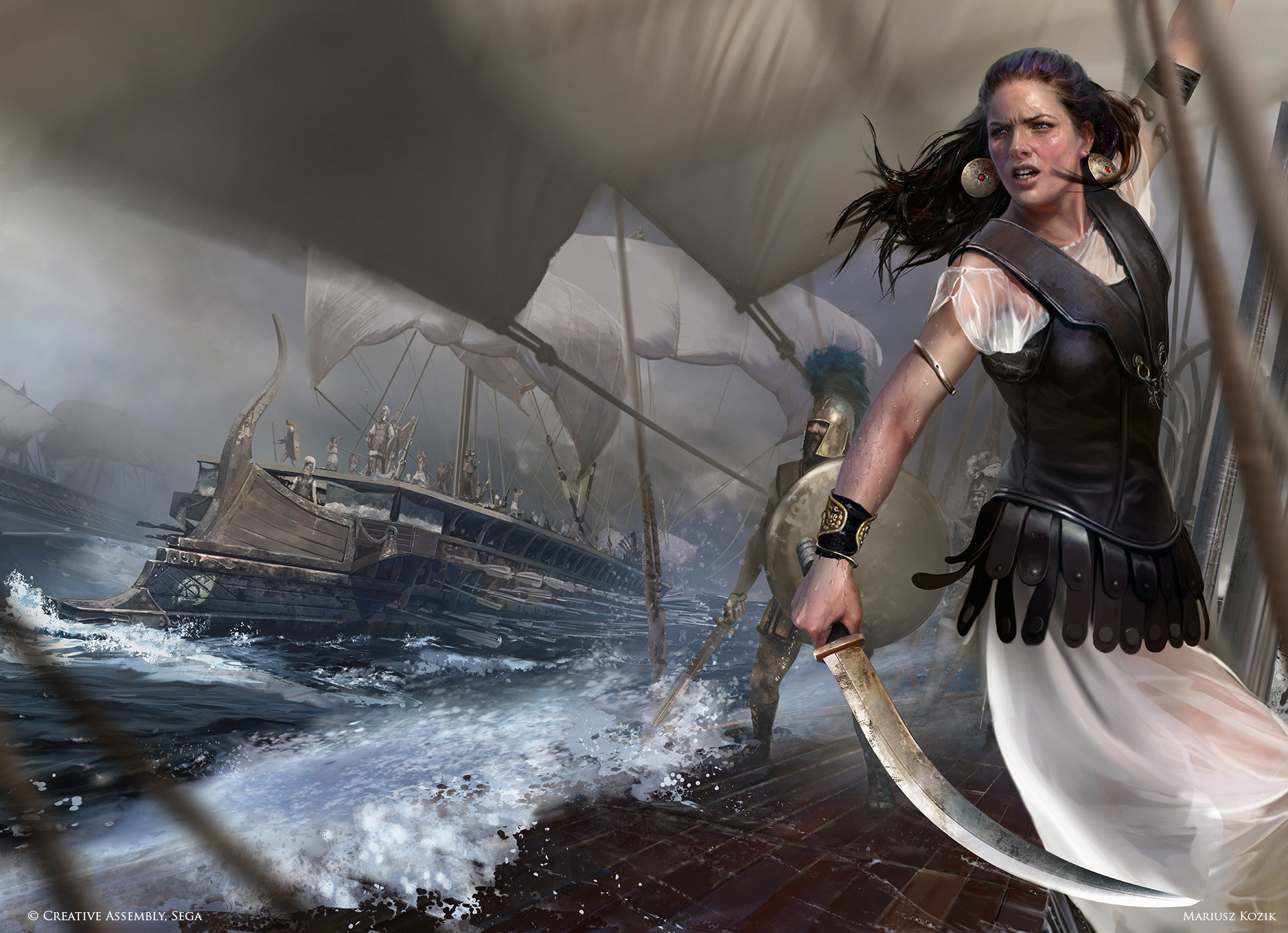
Stunning artwork by Mariuz Kozic for Creative Assembly, showing Queen Teuta of the Ardiaei on a pirate ship
The very reason the Romans declared war on the Illyrian queen Teuta and the illyrian kingdom and its client-states as a whole was motivated by the need to defend their eastern shores from piracy. Piracy was just an extension of the raiding habits of an apparently prolific population living in poverty. It became almost an industry in the Adriatic and the reason, not only why the Romans decided to launch a campaing outside Italy, in the Balkans for the first time, but also after three wars it signalled the end of a civilization, integrated into the oldest provinces of the fledging Roman Empire.
The whole story of it would fill an entire chapter. The Illyrian wars spanned several decades, three wars between 229 and 168 BC. in the first one that spanned just about a year, the Romans captured Epidamnus, Apollonia, Corcyra, Pharos and established a protectorate over these Greek towns, while naming a puppet ruler, Demetrius of Pharos, to balance teuta authority over the region. The second war, 220 BC to 219 BC, saw Demetrios backstabbing the Romans as he profitted that the latter were busy fighting the Celts of Cisalpine Gaul, and Hannibal of Carthage. With a fleet of 90 ships he broke his treaty and rampaged the coast, ransacked Pylos, and raided the Cyclades. His forces were defeated by Lucius Aemilius Paulus. At last, the third war in 171-168 BC saw Illyrian king Gentius swapping sides with Perseus, the last king of Macedon and attacked to Roman allied cities. He was defeated in Scodra by a Roman force under L. Anicius Gallus. Some prmominent tribes such as the Liburnians, Japodes, Delmatae and Ardiaei were recoignised seafarers and ship builders, they were like the "Vikings" of their age. Whereas the Greeks developed heavier warships from the triere, the Illyrians invented a whole range of small ships that were large and agile. Using both rows and sail, their main characteristic was that all rowers were also warriors. They were nimble and fast enough to catch any merchant ship, and possibly also any military galley, and just submerged the crew by sheer numbers. The most common model was later named the "lembos" (plur. lembi), which largely equipped Hellenistic fleets, and spread throughout the Mediterraean. They could carry 50 men in addition to the rowers, 16 to 20. Larger ships were knowned to use double rows (two rowers per bank) or alternate rowing 1, 1-2 like the Hemiolia. The latter was probably also derived from either Illyrian/Ionian or Aegean pirates. The Hemiolia would grew and gradually replace the old Triere in Hellenistic navies.
The king of Macedon once ordered 100 such ships for the first Macedonian war. As a 8-7th Century BC shows, primitive ships had a horse-style prow. Illyrian tactics at sea were unsophisticated but efficient. They had no fancy manoeuvers since they did not possessed a ram and were too light to use it effectively, no tower or upper bridge. Instead they relied in a simple and effective tactic. They offered litteraly to the enemy the flank of one boat, between which other ships will soon be lashed together in groups of four. Then, jumping from boat to boat they would simply overwhelm the enemy ship. There was no known "marine infantry", only regular troops using their ships as attack platforms.
The Liburnians in particular made galaia, a trading galley, a lembus, a fishing ship turned light assault ship (later Croatian levut) and in Byzantine times the drakoforos, with a dragonhead prow. A 10 meters boat from the 1st century BC in Zaton near Nin (Aenona in Classical Liburnia) had a keel with bottom planking made of 6 rows of wooden boards each side sewn with resin cords and wooden wedges. Called "Serilia Liburnica" she was made of Deciduous trees (oak and beech) and climber for the cords. The Romans discovered these in the last illyrian war and during Pompey's "cleaning" of the Mediterranean from piracy, and adopted a variant of their own the Liburna, widely used at the Battle of Actium in 31 BC, when Octavian naval forces chased with Antony's in Greece. The Liburna slowly grew heavier during the Byzantine era, but kept her name and relatively light status.
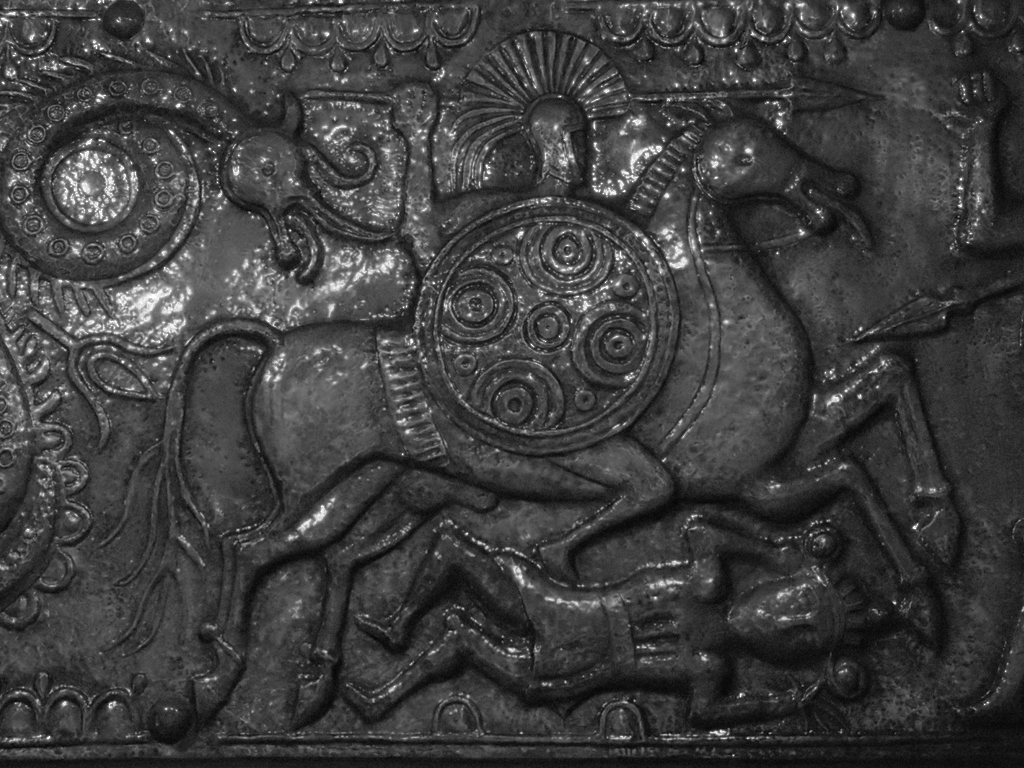
Bas-relief showing Illyrian horsemen
The Illyrian warriors considered there were the Ardiaei, a southern coastal tribe, and their allies. If it's acknowledged that flat oblong shields were of Celtic influence and rather assimilated with northern tribes, like the Dardanians and Dalmatians. However southern tribes generally used round shields. Some were heavy and made of hamerred bronze, for the nobles, while the most current were made of wood, and of the size and shape of the Macedonian pelta rather than an aspsis. They were light and well suited for mountaineers practicing guerilla and raids. Among all weaponry found in many burials, the Sica was arguably the most common. Close in function and shape to the greek Kopis, it was a cutting blade with an inner edge. Most javelins and spears were simple wooden shafts tipped with a mass-produced metal flat leaf-shaped spearhead and rolled spearsocket. However some Illyrian warriors used a long metallic spear called Sibyna. Like boar spears it was short and heavy, and had ears along the spearsocket. The Illyrians made also good use of peasant weaponry such as clubs and maces, but also used battle axes, and single-handed axes that could be hurled. Light troops of slingers and bowmen were also common.
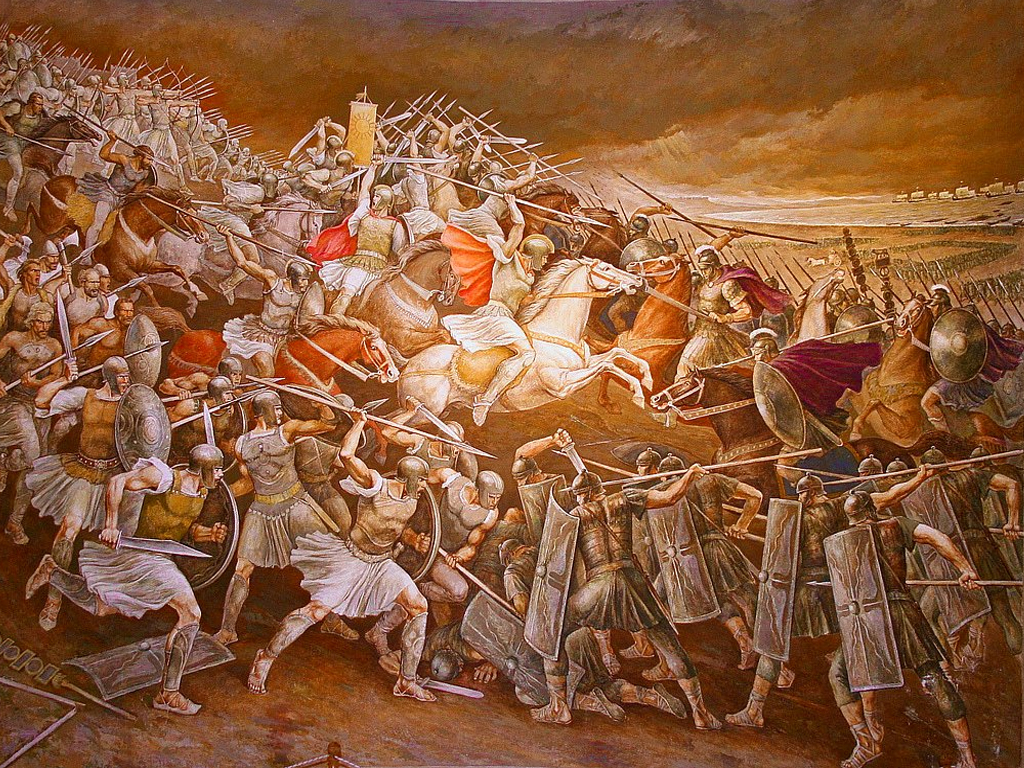
Famous fresco in the Royal palace of Scodra (Shkodër, Albania)
Sources/Read More
BardylisIllyrian warfare
♕ Aquitani & Vasci ♕ Celts ♕ Indo-greeks ♕ Veneti ♕ Yuezhi ♕ Indians ♕ Etruscans ♕ Numidians ♕ Samnites ♕ Judaean ♕ Ancient Chinese ♕ Corsico-Sardinians
⚔ Cingetos ⚔ Immortals ⚔ Cavaros ⚔ Cataphract ⚔ Romphaiorioi ⚔ Chalkaspidai ⚔ Devotio Warrior ⚔ Scythian Horse archer ⚔ The Ambactos ⚔ Iberian warfare ⚔ Illyrian warriors ⚔ Germanic spearmen ⚔ Carthaginian Hoplite ⚔ Thracian Peltast ⚔ Caetrati ⚔ Ensiferi ⚔ Hippakontistai ⚔ Hastati ⚔ Gaesatae ⚔ Cretan Archer ⚔ Thorakitai ⚔ Soldurii ⚔ Iphikrates ⚔ Kardaka ⚔ The thureophoroi